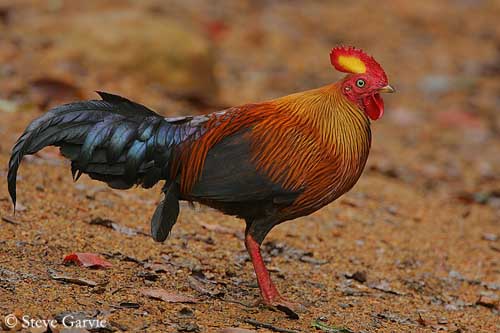
Ceylon Junglefowl
Gallus lafayettii
Galliforme Order – Phasianidae Family
BIOMETRICS:
Length: M: 66-72 cm – F: 35 cm
Weight: M: 790-1140 g – F: 510-625 g
DESCRIPTION:
Ceylon Junglefowl is endemic to Sri Lanka of which it is the National Bird.
Adult male has boldly streaked plumage. Breast and upperparts are fiery yellow to coppery-orange, finely streaked golden. Lower breast, scapulars and back sides are darker bright copper.
Belly, flanks and tail are dark glossy purplish-black. Flight feathers are blackish. The tail is bushy with some longer central rectrices forming with all the tail feathers an elegant panache. Lower back and rump show pale blue feathers turning metallic darker blue on the uppertail coverts.
On the head, the bare face and the two hanging wattles are bright red. Starting from forehead and extending over the top of the crown, a fleshy red crest shows central yellow patch. Chin and throat are purplish-blue.
Bill is yellow to horn-coloured. Eyes are yellow. Legs and feet are red.
After the breeding season, the comb reduces in size.
Fr: Coq de Lafayette
All : Ceylonhuhn
Esp : Gallo de Ceilán
Ital : Gallo selvatico di Ceylon
Nd : Ceylonhoen
Russe : Цейлонская дикая курица
Photographs by Steve Garvie
RAINBIRDER Photo galleries
Text by Nicole Bouglouan
Sources:
HANDBOOK OF THE BIRDS OF THE WORLD Vol 2 by Josep del Hoyo-Andrew Elliot-Jordi Sargatal - Lynx Edicions - ISBN: 8487334156
Citation: Hennache, A. & Ottaviani, M. (2005). Monographie des faisans, volume 1. Edition W.P.A. France, Clères, France. ISBN: 2-9512467-1-4
Citation: Hennache, A. & Ottaviani, M. (2006). Monographie des faisans, volume 2. Edition W.P.A. France, Clères, France.ISBN: 2-9512467-2-2
"Les auteurs renoncent à leurs droits d'auteurs pour que la vente de cet ouvrage, publié par la World Pheasant Association, soit destinée à soutenir des projets de conservation."
Wikipedia (Wikipedia, The Free Encyclopedia)

Female is smaller and very different. She lacks the wattles and shows only a tiny crest behind the bill.
She has very cryptic brown plumage, with typical white markings on underparts where feathers are broadly edged creamy-white.
Wings are heavily barred creamy-white. Upperparts are darker brown finely streaked whitish. Tail is pale rufous, slightly barred dark brown.
Bill is horn-coloured. Eyes are yellow. Legs and feet are dull yellow.
Immature male resembles female, with in addition, some markings of the adult male.
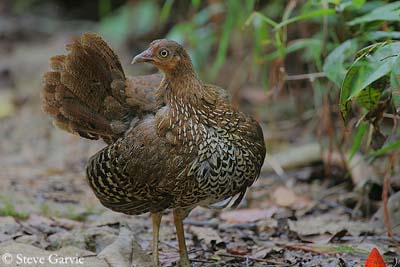
VOICE: SOUNDS BY XENO-CANTO
While foraging on the ground, the Ceylon Junglefowl male utters some short calls “kreeu, kreeu, kreeuu”.
It also utters high-pitched rooster-like crow “cor-cor-chow” at dawn, often from a tree-branch. The female gives some “kwikkuk, kwikkukkuk”.
The male is more vocal during the breeding season with advertising calls and various sounds during displays, as well with female as with rivals and in territorial defence.
HABITAT:
Ceylon Junglefowl frequents forests and coastal scrub to montane rainforests. It may be seen in cultivated areas when searching for food. This species is found from sea-level up to 2000 metres of elevation.
RANGE:
Ceylon Junglefowl is endemic to Sri Lanka.
BEHAVIOUR:
Ceylon Junglefowl is a terrestrial species. It forages on the ground along open roadsides and tracks in forest. It scratches with the feet for seeds, insects and fallen fruits. It forages in the morning and the evening, and mainly after rain. It pecks at the ground for food, as domestic poultry.
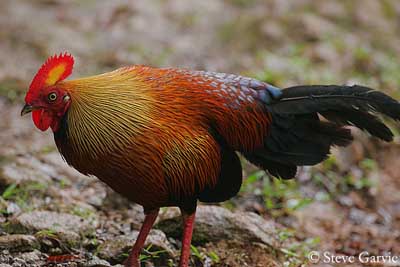
But usually, this bird spends most of the time in forest and dense vegetation, and ventures out only to feed close to the cover.
In the evening, Ceylon Junglefowl flies up into the trees for roosting. It often roosts alone, but sometimes in pairs or family groups. It returns regularly to the same place if not disturbed.
During the breeding season, the male utters advertising calls. Displays are used to expose the beautiful colours of the plumage. The head pattern and the ornaments are brighter and the fiery body feathers are emphasized by the displays. The male struts about close to the female.
During the breeding season, males often fight.
Ceylon Junglefowl is probably sedentary in its range. It may perform some movements according to the food resources, and sometimes travels long distances to feed on their preferred food items.
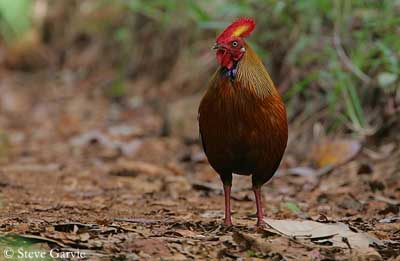
FLIGHT:
As most of Phasianidae, the Ceylon Junglefowl is mostly terrestrial. It takes off when disturbed, in order to reach the protection of the cover. It often flies short distances, but it is able to travel longer distances for food.
REPRODUCTION:
Breeding season may be variable, with peak from February to May, and even to August in Sri Lanka.
Ceylon Junglefowl nests on the ground. The nest is usually placed among vegetation, bushes or under logs. It may use sometimes abandoned nests of squirrels or crows, at several metres above the ground.
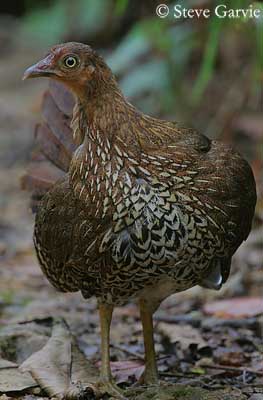
Female usually lays 2-4 eggs. Clutches may be larger, with about 9 eggs, but probably laid by several females. Incubation lasts about 3 weeks in captivity.
Chicks are precocial and start to scratch for food very soon. If threatened, female gives alarm calls and all the chicks reach immediately the protection of the vegetation.
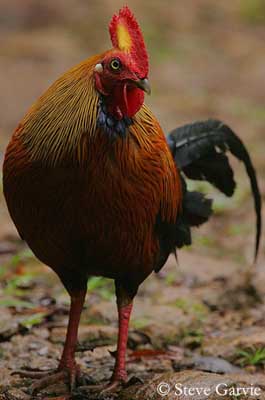
DIET:
Ceylon Junglefowl feeds on plant matter such as grain, seeds, berries, flowers, leaves and buds. It also consumes invertebrates such as termites, crickets, beetles and centipedes.
PROTECTION / THREATS / STATUS:
Ceylon Junglefowl is not threatened at this moment. It is adapted to human disturbances and degradation of the habitat.
This species has restricted range but numbers are stable.